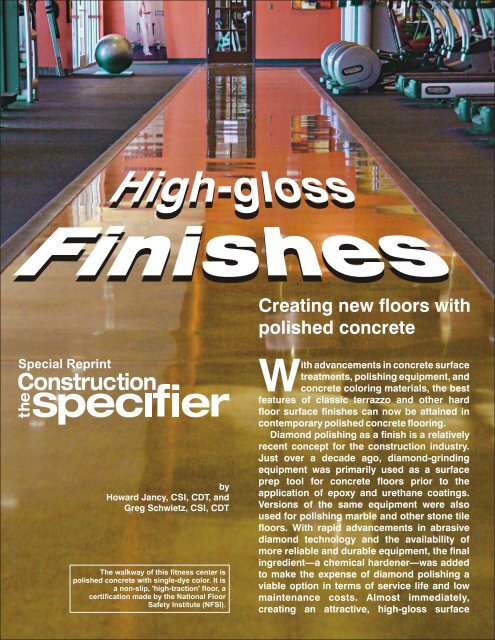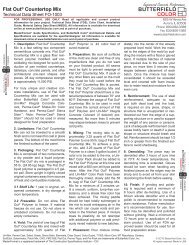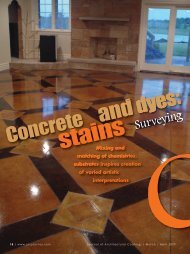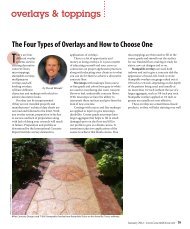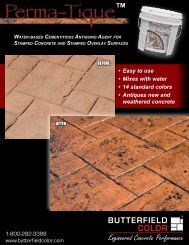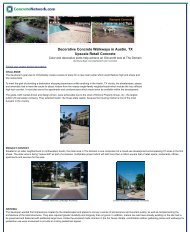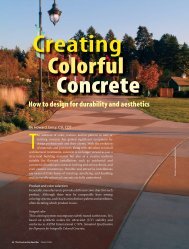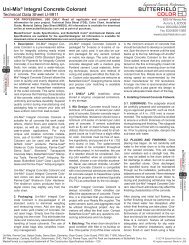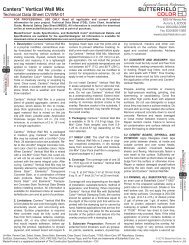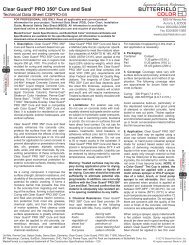Creating new floors with polished concrete - Butterfield Color
Creating new floors with polished concrete - Butterfield Color
Creating new floors with polished concrete - Butterfield Color
Create successful ePaper yourself
Turn your PDF publications into a flip-book with our unique Google optimized e-Paper software.
<strong>Creating</strong> <strong>new</strong> <strong>floors</strong> <strong>with</strong><br />
<strong>polished</strong> <strong>concrete</strong><br />
Special Reprint<br />
by<br />
Howard Jancy, CSI, CDT, and<br />
Greg Schwietz, CSI, CDT<br />
The walkway of this fitness center is<br />
<strong>polished</strong> <strong>concrete</strong> <strong>with</strong> single-dye color. It is<br />
a non-slip, 'high-traction' floor, a<br />
certification made by the National Floor<br />
Safety Institute (NFSI).<br />
ith advancements in <strong>concrete</strong> surface<br />
treatments, polishing equipment, and<br />
W<strong>concrete</strong> coloring materials, the best<br />
features of classic terrazzo and other hard<br />
floor surface finishes can now be attained in<br />
contemporary <strong>polished</strong> <strong>concrete</strong> flooring.<br />
Diamond polishing as a finish is a relatively<br />
recent concept for the construction industry.<br />
Just over a decade ago, diamond-grinding<br />
equipment was primarily used as a surface<br />
prep tool for <strong>concrete</strong> <strong>floors</strong> prior to the<br />
application of epoxy and urethane coatings.<br />
Versions of the same equipment were also<br />
used for polishing marble and other stone tile<br />
<strong>floors</strong>. With rapid advancements in abrasive<br />
diamond technology and the availability of<br />
more reliable and durable equipment, the final<br />
ingredient—a chemical hardener—was added<br />
to make the expense of diamond polishing a<br />
viable option in terms of service life and low<br />
maintenance costs. Almost immediately,<br />
creating an attractive, high-gloss surface
equiring a minimum of ongoing maintenance became the desire<br />
of many building owners.<br />
Polishing is suitable for refurbishing old <strong>concrete</strong> flooring or<br />
producing <strong>new</strong> durable, low-maintenance, high-gloss<br />
installations. This process provides design professionals <strong>with</strong> a<br />
cost-effective flooring option that can accommodate tight budgets<br />
and creative design. As such, it can be found in schools, retail<br />
stores, public buildings, and malls, as well as high-traffic<br />
warehouses and industrial buildings. Polishing allows old <strong>concrete</strong><br />
<strong>floors</strong> to be rejuvenated, adding years of useful life. (Floors<br />
subjected to foot traffic or forklift traffic perform equally well<br />
when <strong>polished</strong>.) <strong>Color</strong> options range from industrial gray or natural<br />
earth tones, to bold and eye-catching reds, blues, and greens.<br />
Polished <strong>concrete</strong> also has sustainable design features. In the<br />
case of existing buildings, this kind of surface greatly reduces the<br />
impact of construction by 'recycling' an old floor. Also, for <strong>new</strong> or<br />
old buildings, polishing <strong>concrete</strong> produces little pollution and uses<br />
non-toxic components (water-based, odorless chemical<br />
hardeners). These benefits contribute toward the accreditation of<br />
buildings under the U.S. Green Building Council's (USGBC's)<br />
Leadership in Energy and Environmental Design (LEED) rating<br />
system. Specifically, <strong>polished</strong> <strong>concrete</strong> <strong>floors</strong> can assist in<br />
obtaining one credit under Materials and Resources (MR), Credit<br />
1, Building Reuse.<br />
Preparing <strong>new</strong> and old <strong>concrete</strong><br />
When properly placed, <strong>new</strong> <strong>concrete</strong> is relatively smooth, flat,<br />
and sound, and generally requires less preparation than most<br />
existing <strong>concrete</strong> being considered for rehabilitation. Depending<br />
on the condition of existing <strong>concrete</strong>, costs may be affected by the<br />
need for additional coarse grinding steps or for patching and<br />
repairing of rough and/or deteriorated sections. The removal of old<br />
sealers, mastic residue, dirt, or other surface contaminants also<br />
adds time and cost to the overall process.<br />
With both <strong>new</strong> and old <strong>concrete</strong> <strong>floors</strong>, a flat surface provides<br />
the most uniform polishing appearance. The mechanical action of<br />
the diamond grinding equipment tends to flatten uneven or warped<br />
<strong>floors</strong>, and in the process, the equipment removes some surface<br />
cement paste. The more paste removed, the more likely this may<br />
partially expose some of the larger aggregate in the <strong>concrete</strong>. Many<br />
Polishing can be used on <strong>new</strong> <strong>concrete</strong> <strong>floors</strong> or to refurbish old<br />
or damaged surfaces. This process can be cost-effective and<br />
allows for creative design elements. Polished <strong>floors</strong> can be found<br />
in stores, public buildings, and shopping malls.<br />
2<br />
Translucent dyes and various grind depths will bring interesting<br />
appearance alternatives to standard gray <strong>concrete</strong> <strong>floors</strong>.<br />
owners find the random terrazzo look to be appealing, and<br />
actually desire it, while others prefer a more uniform appearance.<br />
As such, an on-site mock-up is always recommended to determine<br />
the acceptability of the final aesthetic and avoid having an<br />
unsatisfied client. Adhering to flatness specifications and proper<br />
hard-troweling steps will also greatly affect the floor's final<br />
appearance.<br />
In the case of a <strong>new</strong> floor project, the polishing process can be<br />
completed <strong>with</strong> a minimum of interference <strong>with</strong> the ongoing<br />
operations of an existing facility or <strong>with</strong> other work trades. The<br />
chemical treatment applied after polishing is completely odorless<br />
and dries quickly, allowing treated floor sections to be opened as<br />
soon as they are completed.<br />
The cost of polishing a <strong>new</strong> <strong>concrete</strong> surface is approximately<br />
the same as installing vinyl composition tile (VCT) or epoxy<br />
sealers, exclusive of the cost of ready-mixed <strong>concrete</strong> or coloring<br />
materials. Even so, it is considerably less costly than epoxy<br />
terrazzo <strong>floors</strong> and ceramic tile. Factors affecting the price include<br />
original condition of the <strong>concrete</strong> and size of the project. However,<br />
a limited budget does not restrict the creative possibilities of<br />
colored, <strong>polished</strong> <strong>concrete</strong> as a floor finish.<br />
Specifying <strong>polished</strong> <strong>concrete</strong><br />
Specifications regarding <strong>concrete</strong> polishing are found in<br />
Division 03 of MasterFormat 2004 (MF04), specifically, 03 35<br />
00–Concrete Finishes for <strong>new</strong> <strong>concrete</strong>, and 03 01<br />
30.71–Rehabilitation of Cast-in-Place Concrete. For <strong>new</strong><br />
<strong>concrete</strong> installations, specific mix design requirements help<br />
prepare the material and reduce extra costs in surface<br />
preparation. These authors recommend the following be<br />
included in the related cast-in-place <strong>concrete</strong> specification:<br />
1. Section 03 30 00–Cast-in-place Concrete<br />
Note to specifier:<br />
i. This section must include the following:<br />
1. Minimum <strong>concrete</strong> compressive strength of 23 MPa<br />
(3500 psi).
HIGH TRACTION<br />
Shake-on colored hardeners, polishing, and decorative saw cuts can add dimension. Regular cleaning <strong>with</strong> mild, non-acidic, <strong>concrete</strong><br />
cleaners and conditioners will help the floor hold its gloss longer. This surface does not require wax.<br />
3. Non-air entrained.<br />
4. Natural <strong>concrete</strong> slump of 114.3- to 127-mm (4.5- to 5-<br />
in.) admixtures may be used.<br />
5. Admixtures may be used.<br />
6. Flatness requirements: ASTM International E 1155,<br />
Standard Test Method for Determining FF Floor<br />
Flatness and FL Floor Levelness Numbers.<br />
a) Overall FF 40;<br />
b) Local FF 20;<br />
c) Overall FL not required;<br />
d) Local FL not required.<br />
7. Tight hard-troweled (three passes) <strong>concrete</strong>. No burn<br />
marks. Reference American Concrete Institute (ACI)<br />
302.1R, Guide for Concrete Floor and Slab Construction,<br />
class 5 or class 6 floor.<br />
8. Curing: Options:<br />
a) ASTM International C 309, Standard Specification for<br />
Liquid Membrane-forming Compounds for Curing<br />
Concrete.<br />
i. No acrylic curing and sealing compounds.<br />
b) ASTM C 171, Standard Specification for Sheet<br />
Materials for Curing Concrete.<br />
c) Damp curing, seven-day cure.<br />
d) Curing sheets.<br />
Like terrazzo placement, natural aggregates, sand, and cement<br />
are used when making cast-in-place <strong>concrete</strong>. If desired, specially<br />
3<br />
colored aggregate (natural or manufactured), and sand can<br />
sometimes be integrated into the <strong>concrete</strong> mix design on <strong>new</strong> <strong>floors</strong><br />
for unique colorations, which are exposed <strong>with</strong> polishing. New<br />
<strong>concrete</strong> may also be integrally colored <strong>with</strong> a coloring admixture,<br />
conforming to ASTM C 979, Standard Specification for Pigments<br />
for Integrally <strong>Color</strong>ed Concrete. Numerous earth tone color<br />
admixtures can be blended <strong>with</strong>, or used to highlight, the aggregate<br />
and sand components of the mix design after the floor is <strong>polished</strong>.<br />
This coloring technique and others will be discussed later in the<br />
article.<br />
To reduce unnecessary costly errors on <strong>new</strong> <strong>concrete</strong><br />
placements, a pre-pour meeting between the general contractor, the<br />
<strong>concrete</strong> contractor, and the polishing installer contractor, should<br />
be written into the specification to discuss elevations, finishing,<br />
curing and slab protection. Mock-up panels employing all<br />
materials, tools, and techniques to be used on the job should also be<br />
constructed. Approved or certified <strong>polished</strong> <strong>concrete</strong> installers<br />
should be hired to ensure trained professionals and proper<br />
equipment are used.<br />
Polishing to a glossy finish<br />
The basic piece of equipment used in the polishing process is a<br />
walk-behind, diamond disc grinder for working large floor areas.<br />
The grinder drives diamond-impregnated abrasive discs, which<br />
progress in size from coarse- to fine-grit discs. The condition of the<br />
original <strong>concrete</strong> surface will dictate the grit coarseness of the<br />
initial grinding step. Once the floor is basically flat, the polishing<br />
process proceeds <strong>with</strong> a sequence of multiple steps of increasingly
Retailers often use different colors to identify unique product sections and create a<br />
visual impact. Various colored shake-on hardeners were used on this surface.<br />
finer grit diamond pads until the desired finish is attained. The<br />
final grit level is generally referred to as either a medium, high, or<br />
very high gloss. These terms are relatively subjective and<br />
dependent on <strong>concrete</strong> properties. This process is similar to the fine<br />
sanding of wood.<br />
Grinding and polishing are generally done either wet or dry. If a<br />
wet process is used, a waste slurry is produced that may be difficult<br />
to control inside occupied buildings or on elevated slabs.<br />
Additionally, this slurry can get under racks and other hard-to-reach<br />
areas and requires proper disposal. Grinding slurry must be<br />
disposed of according to local hazardous waste requirements. With<br />
a dry process, a special high-performance vacuum system is used,<br />
which virtually eliminates all airborne dust and debris, simplifying<br />
disposal and keeping the area dust-free.<br />
There is no reported concern regarding silicosis when using the<br />
proper equipment. Concrete dust residue is collected in bags and<br />
disposed of safely in a landfill. In almost all cases, dry grinding is<br />
appropriate and easiest to manage.<br />
Even <strong>with</strong> its gloss, <strong>polished</strong> <strong>concrete</strong> is a safe walking surface.<br />
There are numerous ASTM tests used to indicate slip-resistant<br />
properties of floor sealers, waxes, and other floor finishes.<br />
However, none of these standards work well <strong>with</strong> <strong>polished</strong><br />
<strong>concrete</strong>.<br />
Proper testing will indicate the static coefficient of friction<br />
(SCOF) under both wet and dry conditions. Testing indicates finer<br />
grit levels and higher gloss actually provide a very safe floor for<br />
foot traffic, <strong>with</strong> SCOF readings increasing (i.e. becoming more<br />
slip-resistant) <strong>with</strong> higher gloss levels.<br />
A walk-behind, diamondimpregnated<br />
disc grinder is<br />
used when working on large<br />
floor areas. The surface<br />
condition dictates the<br />
coarseness of the grinding<br />
steps. The disc options range<br />
from coarse-to fine-grit.<br />
Application of a penetrating<br />
densifier is necessary to<br />
provide long term, low cost<br />
protection of the <strong>polished</strong><br />
floor.<br />
4
Polished <strong>concrete</strong> <strong>floors</strong> are becoming a popular design element in retail<br />
stores, corporate office buildings, schools and LEED certified buildings.<br />
The National Floor Safety Institute (NFSI) is an independent<br />
tester of <strong>floors</strong>, including <strong>polished</strong> <strong>concrete</strong>. Its method, NFSI 101-<br />
A, Standard for Evaluating High-traction Flooring Materials,<br />
Coatings, and Finishes, tests treated surfaces twice:<br />
• once, soon after a floor is <strong>polished</strong> and densified; and<br />
• 30 days later to evaluate the effects of normal facility traffic<br />
on the original reading. Surfaces must register SCOF<br />
readings complying <strong>with</strong> the Americans <strong>with</strong> Disabilities<br />
Act (ADA) and Occupational Safety and Health<br />
Administration (OSHA) recommendations at both times<br />
under both wet and dry conditions. Qualifying products are<br />
then certified as 'High Traction.'<br />
These authors recommend choosing a polishing system and<br />
products independently certified by NFSI as high traction. Floor<br />
cleaners and conditioners can also have a significant effect on<br />
ongoing non-slip properties of a <strong>polished</strong> floor. (They should also<br />
be tested to their standards and certified as high traction.) In<br />
<strong>polished</strong> <strong>concrete</strong>, densifiers penetrate into the 'near surface wear'<br />
zone. Therefore, since there is no surface coating, there is also no<br />
surface film to scratch, chip, peel, or discolor and, as a result, the<br />
natural, no-slip nature of <strong>concrete</strong> is retained.<br />
<strong>Color</strong>ing and protecting <strong>polished</strong> surfaces<br />
While gray <strong>concrete</strong> is the norm, color can add significant<br />
dimension to a <strong>polished</strong> floor. With <strong>new</strong> installations, integral color<br />
can be added to the fresh <strong>concrete</strong> mix, or for a more intense effect,<br />
installed by the <strong>concrete</strong> contractor as a shake-on color hardener.<br />
The floor of this car dealership is <strong>polished</strong> <strong>concrete</strong> <strong>with</strong> a<br />
natural appearance and decorative saw cuts.<br />
<strong>Color</strong> can also be applied to hardened <strong>concrete</strong> in the form of a<br />
reactive stain or penetrating dye after the polishing process.<br />
Whether the <strong>concrete</strong> is plain gray or integrally colored, the<br />
application of a reactive chemical stain will create translucent and<br />
variegated colorations. (For more information, see “<strong>Color</strong>ing<br />
Polished Concrete Floors” on page 7.) <strong>Color</strong> options range from<br />
industrial gray to reds, blues, and greens.<br />
Once the floor has achieved the desired polish and color, it is<br />
still comparatively soft. Two factors come into play at this time.<br />
The first factor influencing the softness of the surface is the fact<br />
5
<strong>Color</strong>ed admixtures, shake-on color hardeners, penetrating chemical stains and dyes add interest and beauty to <strong>polished</strong> <strong>concrete</strong> <strong>floors</strong>.<br />
part of the <strong>concrete</strong>'s hard-troweled surface is removed during<br />
the polishing steps. Microscopic inspection reveals an open-pore<br />
structure and cement matrix now more vulnerable to wear. Second,<br />
because such a high gloss can be obtained by polishing <strong>concrete</strong>, a<br />
common misconception is to believe the process has closed up the<br />
floor when the exact opposite has occurred.<br />
After polishing, it is imperative the finish always be protected<br />
<strong>with</strong> an odorless, non-toxic chemical hardener and densifier. In<br />
simple terms, proper chemical treatment restores strength to the<br />
abraded 'near surface wear' zone of the <strong>concrete</strong> (i.e. the top 1.6 to<br />
3.2 mm [1/16 to 1/8 in.] of the floor). Chemical treatment also<br />
makes the <strong>concrete</strong> surface harder, denser, and more abrasion- and<br />
contaminant-resistant. There are several formulations of liquid<br />
hardeners on the market. In the authors' opinion, a densifier is best<br />
applied after polishing, as opposed to during the process. However,<br />
this depends on original floor condition and manufacturer<br />
recommendations.<br />
Maintaining a <strong>polished</strong> surface<br />
Adherence to a recommended cleaning schedule also helps the<br />
floor hold its mechanically <strong>polished</strong> gloss longer and greatly<br />
reduces the absorption of spilled liquids (except for strongly acidic<br />
or alkaline materials), <strong>with</strong>out the application of maintenance<br />
sealers or waxes. Floor wax or topical sealers are never needed on a<br />
<strong>polished</strong> <strong>concrete</strong> floor. Maintenance costs stay low, usually in the<br />
range of $0.25 to $0.50 per square foot per year. This cost estimate<br />
is less than half the estimated annual cost to maintain a simple floor<br />
wax. Installing a <strong>polished</strong> <strong>concrete</strong> floor can add up to hundreds of<br />
thousands of dollars in savings over the life of the building on an<br />
2<br />
area measuring 929 m (10,000 sf). The treated <strong>concrete</strong> floor is<br />
easily maintained by regular cleaning <strong>with</strong> periodic dry and wet<br />
mopping. Mild, non-acidic, <strong>concrete</strong> cleaners and conditioners are<br />
recommended for everyday care.<br />
For a successful project, the authors recommend the design<br />
team consider the following:<br />
1. There are national programs using certified and trained<br />
applicators and it is wise to insist on employing only<br />
approved installers, equipment, and products.<br />
2. <strong>Color</strong> and color types to be used (e.g. shake-on hardener,<br />
integral color, reactive stain, penetrating dye) should be<br />
clearly specified.<br />
3. A minimum five-step process for a base bid is<br />
recommended, <strong>with</strong> incremental steps bid as an addendum<br />
once the final finish is determined by the project<br />
conditions and owner's representative.<br />
4. A compatible chemical hardener and densifier must be<br />
applied at the end of the process. It should be certified as<br />
non-slip, and if possible, carry the NFSI designation for<br />
high traction.<br />
5. Mock-ups are recommended, and should be installed using<br />
available materials and equipment, demonstrating<br />
aggregate exposure, shine, and color options.<br />
6. Polished <strong>concrete</strong> work should be protected after<br />
installation until the owner takes possession.<br />
Additional Information:<br />
Authors<br />
Howard Jancy, CSI, CDT, is business development<br />
manager for <strong>Butterfield</strong> <strong>Color</strong>, which manufactures coloring<br />
materials, stamping tools, and related products for the decorative<br />
treatment of <strong>new</strong> or existing <strong>concrete</strong>. He has been involved in the<br />
decorative <strong>concrete</strong> industry for 20 years. Jancy is a founding<br />
board member of the Decorative Concrete Council (DCC), an<br />
affiliate of the American Society Of Concrete Contractors (ASCC).<br />
He can be contacted via e-mail at howard@butterfieldcolor.com.<br />
Greg Schwietz, CSI, CDT, is president of L&M<br />
Construction Chemicals, which produces chemical treatment for<br />
the construction, repair, and protection of <strong>concrete</strong>. He has been a<br />
member of the Construction Specifications Institute (CSI) for 30<br />
years and continues to support his company's involvement in CSI<br />
on a national, regional, and local level. Schwietz can be contacted<br />
via e-mail at gschwietz@lmcc.com.<br />
MasterFormat No.<br />
03 30 00–Cast-in-Concrete<br />
03 35 00–Concrete Finishing<br />
03 35 19–<strong>Color</strong>ed Concrete Finishing<br />
UniFormat No.<br />
C3020–Floor Finishes<br />
Key words<br />
Division 03<br />
Dying <strong>concrete</strong><br />
Integral coloring admixtures Penetrating chemical stains<br />
Polishing <strong>concrete</strong><br />
Shake-on color hardeners<br />
Abstract<br />
Polishing <strong>concrete</strong> can be used to refurbish old or damaged<br />
<strong>floors</strong> or add dimension to <strong>new</strong> ones. The process to attain<br />
glossy surfaces is discussed, along <strong>with</strong> safety standards,<br />
maintenance, and chemical treatments to protect <strong>floors</strong>. This<br />
discussion also includes an overview of materials use to color<br />
<strong>concrete</strong> surfaces to add a further decorative element.<br />
6
<strong>Color</strong>ing Polished Concrete Floors<br />
The successful installation of <strong>polished</strong> <strong>concrete</strong> <strong>floors</strong><br />
requires an understanding of how various tools and<br />
processes affect a surface. Introducing color to a<br />
<strong>polished</strong> floor is not just a matter of making a color choice. It<br />
requires a good understanding of the different coloring products<br />
available and how they impact the installation of <strong>polished</strong><br />
<strong>concrete</strong>. There are basically four products or methods for<br />
coloring gray <strong>concrete</strong>. Each has its own distinct color palette<br />
and method of application.<br />
Admixtures<br />
Integral coloring admixtures are available as either powder or<br />
liquid colorants, which are added to ready-mixed <strong>concrete</strong> at the<br />
batch plant. Generally used <strong>with</strong> a gray portland cement mix<br />
design, the products result in subtly muted earth tones. The<br />
integrally colored <strong>concrete</strong> can be placed full-depth or as a 50-<br />
mm (2-in.) topping over the structural slab. The latter method<br />
allows the various trades to work over the gray <strong>concrete</strong><br />
structural slab <strong>with</strong>out worrying about damaging or soiling the<br />
finished floor.<br />
Once the interior work is completed, the <strong>concrete</strong> contractor<br />
can then install the topping. This can minimize the cost of<br />
protecting the surface while the floor is curing, and the cost of<br />
cleaning prior to grinding and polishing the <strong>concrete</strong>. It is<br />
important to remember not to use a membrane-forming curing or<br />
sealing compound on <strong>new</strong> <strong>concrete</strong>, as this can interfere <strong>with</strong> the<br />
polishing process. The use of wet curing or curing sheets is more<br />
appropriate.<br />
Shake-on color hardeners<br />
Another material that can be used to color <strong>new</strong> <strong>concrete</strong> is a<br />
shake-on color hardener. A prepackaged blend of silica quartz<br />
sand, cement, and color, this material is topically applied and<br />
finished into uncured <strong>concrete</strong>, forming a very durable layer of<br />
color. Compared to a coloring admixture, shake-on products<br />
offer a greater range of lighter and more vibrant hues, as well as<br />
select greens and blues. Geometric patterns or unique and<br />
natural variations can also be created <strong>with</strong> individual colors or<br />
by combining colors.<br />
A significant benefit of using a shake-on color hardener is<br />
that it creates a very dense and wear-resistant surface. When<br />
combined <strong>with</strong> the densifying effect of the liquid hardener after<br />
polishing, the floor is well-suited for use in areas <strong>with</strong> high foot<br />
and vehicular traffic (e.g. industrial facilities or 'big-box' stores.)<br />
Shake-on color hardener is broadcast onto gray <strong>concrete</strong><br />
when the floor is being installed. It cannot be effectively or<br />
correctly applied to existing cured <strong>concrete</strong>. <strong>Color</strong> hardener is<br />
usually broadcast manually. However, for large installations such<br />
as industrial <strong>floors</strong>, a mechanical hopper may be used to quickly<br />
apply the product. After broadcasting, the product is finished by<br />
hand and machine, and allowed to cure before polishing. The<br />
finishing process tools and timing are the same as for gray<br />
<strong>concrete</strong>. It is important to not use liquid-applied curing or<br />
sealing compounds over the color-hardened surface since it will<br />
have to be removed prior to polishing, adding time and cost to<br />
the installation.<br />
Penetrating chemical stains<br />
A reactive penetrating chemical stain can be used when<br />
coloring an existing or older <strong>concrete</strong> floor. This material can be<br />
applied to gray <strong>concrete</strong> or a surface colored via an admixture or<br />
shake-on color hardener. Penetrating chemical stains are liquid<br />
materials that react <strong>with</strong> the cement component of <strong>concrete</strong>,<br />
creating translucent and mottled colors.<br />
Since results can vary <strong>with</strong> <strong>concrete</strong> age and mix design,<br />
these authors recommend doing a mock-up. While there are a<br />
limited number of earth tones, stain colors can be combined and<br />
manipulated during application for eye-catching results. Multiple<br />
applications of the stain can be done for deeper colors. However,<br />
once the reactive ingredient in the <strong>concrete</strong> is depleted,<br />
additional applications may prove ineffective. This is<br />
particularly true <strong>with</strong> old <strong>concrete</strong> and should be verified during<br />
the mock-up process. If the coloration reaction is less than<br />
desired, the use of a dye combined <strong>with</strong> a reactive stain should<br />
be evaluated.<br />
This chemical process leaves a residue after reacting <strong>with</strong> the<br />
<strong>concrete</strong>, and the floor will require thorough scrubbing,<br />
neutralizing, rinsing, and drying time before it can be opened to<br />
traffic. The surface can be neutralized by applying a solution of<br />
0.5 kg (1 lb) of baking soda mixed into 19 L (5 gal) of clean<br />
water. The solution is then manually scrubbed <strong>with</strong> stiff-bristled<br />
brushes, rotary floor-scrubbing machines, or powered, walkbehind<br />
washing/scrubbing machinery. After scrubbing, the wet<br />
residue should be wet-vacuumed off the surface. It should not<br />
come into contact <strong>with</strong> plain gray <strong>concrete</strong> or alternately colored<br />
surfaces as the residue may discolor those areas. It is also<br />
possible to create shapes and patterns <strong>with</strong> shallow saw cuts<br />
followed by staining <strong>with</strong> one or more colors.<br />
Dyes<br />
Dyes can also be used to alter existing interior gray or<br />
colored <strong>concrete</strong>. However, they are not ultraviolet (UV)-stable<br />
and can potentially fade when used outside. As previously<br />
mentioned, dyes are a good companion coloring product when<br />
working <strong>with</strong> reactive chemical stains. Composed of micronized<br />
organic pigments in a solvent carrier, these materials are sprayapplied<br />
and then penetrate into a <strong>concrete</strong> surface, creating<br />
natural and translucent colors. Single and multiple applications<br />
are possible. (Applying dyes more than once makes for richer<br />
colors.) However, after three or four applications, the <strong>concrete</strong><br />
surface usually rejects additional material and the color will not<br />
change. This should also be verified <strong>with</strong> a mock-up. Unlike<br />
reactive chemical stains, there are more colors available and the<br />
effect can be less mottled.<br />
Dyes are usually applied at the grit level just prior to the final<br />
polishing step. They dry in minutes, allowing the final polishing<br />
and liquid hardener application to continue <strong>with</strong> minimal<br />
downtime once the dye residue is removed. This can be achieved<br />
<strong>with</strong>out the use of water or any cleaning agent—simply running<br />
over the floor surface <strong>with</strong> a white buffing pad is sufficient. This<br />
easy removal is advantageous in occupied areas or elevated<br />
<strong>floors</strong> where the use and control of water can be difficult. Shapes<br />
and patterns may also be introduced <strong>with</strong> shallow saw cuts.<br />
7


